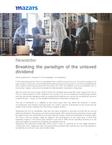
Breaking the paradigm of the untaxed dividend
In the corporate psyche, there is a paradigm that is held by many to be true: "since the company has been taxed on the profit, it can be distributed without taxes to the partners". As will be studied below, and in spite of deriving this premise from article 49 of the Tax Statute, this is only partially true, in income tax matters, and when the dividend is distributed to Colombian companies.
With the entry into force of Law 1819 of 2016, the dividend was taxed with a tax ranging from 0% to 10% for natural persons ("PN") resident in the country, 5% for non-residents (including legal entities and their permanent establishments) and retained its treatment as income not constituting income or occasional gain - Incrgo- for the dividend distributed to Colombian companies.
This tax on dividends is in addition to two other taxes that may affect the dividend in certain circumstances; the Industry and Commerce Tax ("ICA") and the contributions to the social security system that must be made by the PNs that are capital rentiers.
Regarding the ICA on dividends, case law has been emphatic in pointing out that this tax cannot affect the dividend, if the shares are held as fixed assets. With respect to the contributions to be made by capital rentiers (for dividends) to the social security system, several considerations must be made. The first is that the charges made by Ugpp for the contributions of the years prior to 2015 lack regulatory support, in the sense that, based on Law 100 of 1993 and its regulatory decrees, it is not clear that capital annuitants for dividends are obliged to do so.
Regarding the collections made after 2015, there is also no certainty as to how Ugpp intends to "monthlyize" them, especially when the partnership contracts often extend over very long periods or sometimes do not even have a termination date.
The exercise of a PN and a corporation each receiving a dividend (of $100, $200, $500 and $1,000 million) on which the paying entity has already paid taxes, leads to the following conclusions: (i) only in the case of the dividend of $100 million, the total cost of receiving the dividend would be higher for the corporation than for the PN, since only for the former the monthly accounting fees under Niif, the annual item of preparation of tax returns, renewal of commercial registration and industry and commerce tax (assuming that the same applies) are included.
In such case, while for the PN the total cost (expense and taxes) for receiving the dividend would be $13,585,396, for the corporation it would be $15,119,598 (ii) with respect to the $200 million dividend, the cost for the PN would be $23,585,396 while for the corporation it would be $16,019,598, (iii) with respect to the $200 million dividend, the cost for the PN would be $23,585,396 while for the corporation it would be $16. 019,598, (iii) with respect to the $500 million dividend, the cost to the PN would be $53,585,396 while for the corporation it would be $18,819,598 and (iv) with respect to the $1 billion dividend, the cost to the PN would be $103,585,396 while for the corporation it would be $23,319,598.
In conclusion, the tax and contribution overload has distorted the paradigm of the untaxed dividend, making it much more profitable to receive the dividend through a corporation than directly as an individual.


